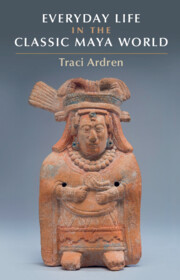3 - Fields and Forest
Published online by Cambridge University Press: 01 June 2023
Summary
Maize, or what most people in the United States call corn, was at the heart of ancient Maya culture. It provided the main source of calories, it was the main ritual offering and feast food, and corn deities were central to the guiding mythologies that made royal rulership possible. By the Classic period maize agriculture required constant attention as the plant had become completely dependent on human intervention through the domestication process. Maize is often depicted in Classic art as a delicate, young child, in need of protection. The shared practices of planting, tending, harvesting, and processing maize unified Maya communities and provided a keystone to their cultural identity. Indigenous growing techniques were refined for the tropical climate of the Maya area, but corn was still dependent on the arrival of regular rains, not always a guaranteed phenomenon in the tropics. Maya farmers were greatly assisted in securing agricultural success by the large beehives they kept at the edges of their fields. Native stingless bees produced honey and wax but were perhaps most important for their role in pollination of agricultural plants. Many wild resources were harvested from the rich rainforests that surrounded every settlement. The forests were places of unruly spirits and untapped potential. They were respected as reservoirs of plants, animals, and minerals needed for daily life. Research has shown that many of the forest management techniques used during the Classic period survive today in the most remote areas of the Maya world, and we have learned much about ancient plant and animal management from the modern Indigenous people of southern Mexico, Belize, and Guatemala. Within the animate Maya landscape, filled with spirits of place, caves and underground sources of fresh water took on special significance. They were places to connect with the forces of creation and a primary location for rituals of fertility and rain.
- Type
- Chapter
- Information
- Everyday Life in the Classic Maya World , pp. 46 - 68Publisher: Cambridge University PressPrint publication year: 2023



